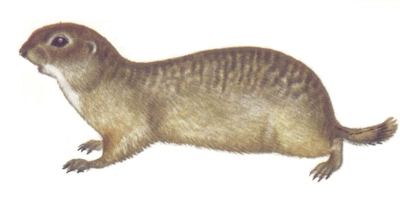Pests
Citellus (Colobotis) pygmaeus (Pallas, 1778) - Little souslik.
Systematic position.
The class Mammalia, order Rodentia, suborder Sciuromorpha, family Sciuridae, subfamily Marmotinae, genus Citellus, subgenus Colobotis. The species includes 10 recognized subspecies.Biological group.
Rodent pests.Morphology and biology.
Body length, up to 230 mm; tail length, up to 40 mm (usually 18-25 % of body length). The dorsum coloration is brownish-grey, with addition of ochre tones and with yellowish mottling of different intensity. Head coloration is notably darker than back (from dorsal view) and with more intensive ochre tones. Tail light, grayish-ochre with light apex or with light marginal limb. Diploid set of chromosomes, 36. Species has a colonial mode of life, builds burrows, and hibernates. Inhabits semi deserts, and also parts of desert and steppe regions. Settles on common pastures, pastures, and roadsides. Avoids and leaves lands that are plowed, remaining only at field edges (100-150 m). Builds burrows of two types: constant and temporary. For winter all exits are plugged by soil; in the spring entrances are opened, burrows cleaned and new construction started. As a result of digging activity over several generations a mound is formed on the surface (7-8 m in diameter and up to 0.6 m in height), so-called "souslikovina". This is usually a center of fodder. From the top of the souslikovina, animals observe the environs. When threatened they emit a sharp singing sound, and all sousliks retreat to burrows.Distribution.
Very widespread in the territory of the former Soviet Union, in the European part (southern and southeast regions), in western and partly northern Kazakhstan. The border of geographic area passes from middle Dnepr (Cherkassk and Poltava Regions) in the west to Tselinograd, Karaganda, western suburbs of Muyunkum and Betpak-Dala in the east; to the Black Sea and Azov Sea coasts in the south, to submontane parts of Crimea, from Rostov-na-Donu to Stavropol, Pyatigorsk, Mozdok, Malgobek, north of Groznyi and Gudermes, up to the Alpine belt of Dagestan, north of Ustyurt and lower Syr Darya; to the north, almost to Poltava and further on east approximately along the line: Izyum - Mal'chevskaya - Kalach - Uryupinskaya - Saratov - Kinel' - Khaibullino - Troitsk - Kustanai - Atbasar - Shadrinsk - Tselinograd.Ecology.
Well adapted to hot and arid climate. The species is active during the day, except during the hottest part. During the year it is active for 80-100 days. Dates of awakening and hibernation are variable, depending on the condition of food supply in the last season, on weather conditions of current year, and on the physiological state of animals. Feeds on both above-and below ground parts of plants. The ratio of shoot to root eaten varies, depending on season, station, and part of geographic area. Fattening forage before hibernation includes seeds, and also nodules of annual meadow-grasses. Does not store food reserves. During arid years the species will migrate looking for new fodder sites. Reproduction occurs once a year. Quantity of females participating in reproduction varies from year to year and depends on nature of spring (late or early) and physiological condition of females based on feeding in previous year. Average number of young is 3-5 to 8-10 in a brood. Population dynamics is determined by many factors including natural death rate, which is rather high, especially among young animals during hibernation.Economic significance.
Species is most harmful of genus. Damages all agricultural crops including vegetables, melons, and gourds. Destroys sowings of perennial grasses, and on pastures feeds on the most valuable forage plants, which are replaced by weeds. Regular digging activity decreases productivity of the pastures. The pest essentially damages shelterbelt forests when they are planted. Control includes mechanical, chemical, and biological measures. Grain baits with zinc phosphide are the most effective. A noticeable decrease in population numbers is observed when virgin or long-fallow lands are plowed. High levels of agriculture and presence of small predators also limits population growth. The species has a prime epidemiological significance since it is a vector of plague infection and other transmissible diseases.Reference citations:
Gromov I.M., Bibikov D.I., Kalabukhov N.I., Meyer M.N. 1965. Terraneous Marmotinae. Fauna SSSR. Mammals. Moscow-Leningrad: Nauka. V. 3(2): 467. (In Russian)Gromov I.M., Erbaeva M.A. 1995. Mammals of Russia and adjacent territories. Leporids and rodents. Keys to Russian Fauna published by Zoological Institute of Russian Academy of Science (RAN). St. Petersburg: ZIN RAN. N.167: 522. (In Russian)
Movchan O.T. 1953. Some ecological features of little souslik (Citellus pygmaeus Pall.) on northern and southern borders of geographic area. Proceedings of Volga antiepidemic station. Astrakhan': Volga. N. 1: 154-177. (In Russian)
Varshavskii S.N., Krylova K.T. 1939. Ecological features of little souslik population (Citellus pygmaeus Pall.) in the miscellaneous periods of life. Zool. zhurn. 18(6): 1026-1047. (In Russian)


